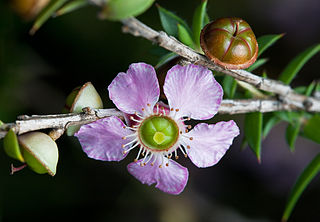
Leptospermum is a genus of shrubs and small trees in the myrtle family Myrtaceae commonly known as tea trees, although this name is sometimes also used for some species of Melaleuca. Most species are endemic to Australia, with the greatest diversity in the south of the continent but some are native to other parts of the world, including New Zealand and Southeast Asia. Leptospermums all have five conspicuous petals and five groups of stamens which alternate with the petals. There is a single style in the centre of the flower and the fruit is a woody capsule. The first formal description of a leptospermum was published in 1776 by the German botanists Johann Reinhold Forster and his son Johann Georg Adam Forster, but an unambiguous definition of individual species in the genus was not achieved until 1979. Leptospermums grow in a wide range of habitats but are most commonly found in moist, low-nutrient soils. They have important uses in horticulture, in the production of honey and in floristry.

Pittosporaceae is a family of flowering plants. The family includes approximately 200–240 species of trees, shrubs, and lianas in 9 genera. The species of Pittosporaceae range from tropical to temperate climates of the Afrotropical, Indomalayan, Oceanian, and Australasian realms.

Isotoma is a genus of annual and perennial herbs in the family Campanulaceae and are native to Australia and New Zealand.

Triodia is a large genus of hummock-forming bunchgrass endemic to Australia. They are known by the common name spinifex, although they are not a part of the coastal genus Spinifex. Many of the soft-leaved members of this species were formerly included in the genus Plectrachne.

Gastrolobium is a genus of flowering plants in the family Fabaceae. There are over 100 species in this genus, and all but two are native to the south west region of Western Australia.

Mirbelia is a plant genus belonging to the family Fabaceae. It is endemic to Australia, occurring in every mainland state except South Australia.

Bursaria is a genus of large shrubs and small trees which are native to Australia. The genus was first described by Antonio Cavanilles in 1797, with his description of the type species B. spinosa. The name is derived from the Latin word bursa (purse) which relates to the shape of its seed capsules.

Billardiera is a genus of small vines and shrubs in the family, Pittosporaceae, which is endemic to Australia. The genus was first formally described in 1793 by botanist James Edward Smith who named it in honour of Jacques Labillardière, a French botanist.

Daviesia, commonly known as Bitter-peas, is a large genus of flowering plants in the legume family. They are native to Australia, with a centre of diversity in Western Australia.

Gastrolobium sericeum is a shrub in the family Fabaceae. It is endemic to the south-west of Western Australia.

Gastrolobium lehmannii or Cranbrook Pea is a vulnerable shrub in the family Fabaceae which is endemic to an area of Western Australia.
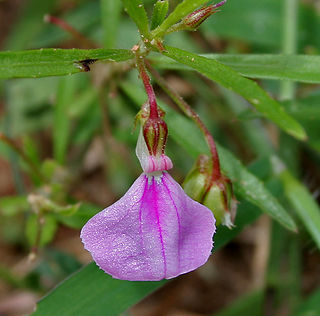
Hybanthus (greenviolet) is a genus of the family Violaceae. This genus name is Greek for "humpback flower", referring to the drooping pedicels of plants that are part of this genus. The genus is grossly polyphyletic and may contain up to nine different genera, of which Pombalia Vand., Cubelium Raf. and Pigea DC. have been previously recognised.
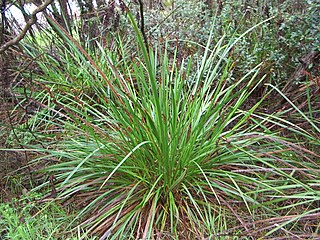
Lepidosperma is a genus of flowering plant of the family Cyperaceae. Most of the species are endemic to Australia, with others native to southern China, southeast Asia, New Guinea, New Caledonia and New Zealand.
Gastrolobium rubrum is a shrub in the family Fabaceae. It is endemic to the south west of Western Australia.
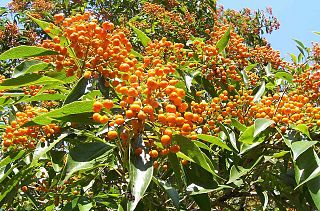
Auranticarpa is a genus of trees in the family Pittosporaceae. All six species occur in monsoonal forest and rainforest margins in Northern Australia. The species, all formerly included in the genus Pittosporum, are as follows:

Pittosporum multiflorum, known as the orange thorn, is a shrub growing in eastern Australia. The dense foliage provides a habitat for small birds and animals. It grows on shales or volcanic soils, from Eden, New South Wales north to Queensland, usually in or near rainforest areas.
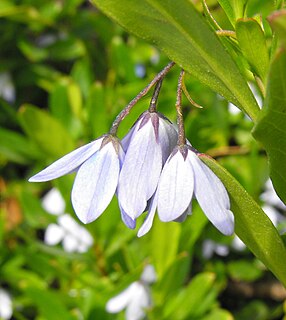
Billardiera heterophylla is a species of flowering plant in the family Pittosporaceae, known by the common name bluebell creeper. It is native to Western Australia, but is grown as an ornamental plant in appropriate climates worldwide. It can sometimes be found growing in the wild as an introduced species or garden escapee, for example in other Australian states and in California, where it is popular in landscaping. It is sometimes considered a weed.
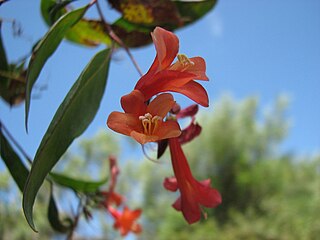
Marianthus is a genus of flowering plants within the family Pittosporaceae.

Billardiera fraseri is a species of plant in the family, Pittosporaceae, which is endemic to Western Australia.


















